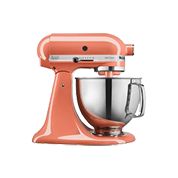Tips for Slow Cooker
Tips for Using the KitchenAid Slow Cooker
This KitchenAid® Slow Cooker offers refinements in control that helps the cooker be a more useful tool and power to add responsiveness and peace of mind.
Sure and Steady Cooking
A Slow Cooker is designed for you to put food into it, walk away from it without a worry, and return to a well-cooked meal. So it’s important to let it do its job. That means you should always cook with the ceramic pot and glass lid in place because removing the lid reduces the temperature inside the slow cooker and increases cooking time.
Except where a Slow Cooker recipe specifically directs you to remove the lid, do not remove or lift the lid until the minimum suggested recipe-cooking time has elapsed. If you want to view the food you’re cooking, tap the glass lid to remove the condensation that has collected and look through the cover.
Start With Food at the Right Temperature
Make a practice of knowing the right temperature for food when you start cooking in a Slow Cooker. Foods typically stored in the refrigerator should be added at their refrigerated temperature. Frozen food, on the other hand, should be thawed. And if you need to sear meat or poultry, do that just before adding it to the Slow Cooker – do not partially cook meat or poultry and then refrigerate before using.
Avoid adding liquids colder than normal refrigerated temperatures. Adding near-freezing liquids to a warm or hot pot may cause the container to crack.
A Slow Cooker is a Humid Environment
Slow Cookers use food’s moisture to cook the food. With the lid kept on while cooking, very little moisture evaporates, and natural juices from the food accumulate. For that reason, use less liquid when using your favorite traditional recipes for slow cooking.
Enhancing Texture and Flavor
- The amount of seasonings, types of ingredients, and when you add ingredients can improve the texture and flavor of your slow-cooked meals.
- As a general rule for using your favorite recipes in the slow cooker, increase the amounts of herbs and seasonings to offset the effect of longer cooking times.
- Add garnishes, fresh herbs, and quick-cooking vegetables toward the end of the cooking cycle. For example, you can add peas, corn, and freshly sliced squash in the last 10 to 20 minutes.
- Also, consider the differences between related ingredients when cooking for extended times. Dark meat poultry will retain moisture better than white meat in recipes cooked more than 7 to 9 hours. Whole-grain rice, such as brown or wild rice, retains its texture better than white rice when it’s slow-cooked. Overextended periods, white rice can overcook and become mushy.
- When cooking soups and stews, leave a 2 inch (5 cm) space between the top of the ceramic pot and the food so the recipe can come to a simmer without spilling over.
- Do not use frozen, uncooked meat in the slow cooker. Always thaw meats before slow cooking.
- Some foods are not suited for extended cooking. Pasta, seafood, milk, cream, or sour cream should be added 2 hours before serving.
- If cooking a vegetable-type casserole, there will need to be a liquid in the recipe to prevent scorching on the sides of the ceramic pot.
Cut Food to Proper Size
The size you cut food into can affect its taste and texture. To assure uniformity of cooking, cut vegetables of similar density, such as potatoes, carrots, and parsnips into similar-sized pieces. In general, dense vegetables should be slightly smaller than more tender vegetables.
Cutting meats into large pieces allows longer cooking times and avoids overcooking.
Still need help? Contact us or schedule service.
Please contact us or click below to make an appointment from our preferred list of service providers for service on your appliances.
United States
Canada
Interested in purchasing an Extended Service Plan?
Please click below to learn more on how you can save up to 25% on New Appliance Extended Service Plans within 30 days of your appliance purchase.
United States
Canada










.png)

























